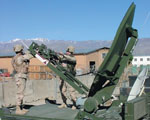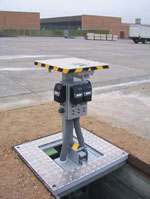Command Goes to New Wavelengths to Transform Operations in Europe
 |
| Spc. Damian Fugate, USA, and Spc. Matthew Evans, USA, adjust a Phoenix satellite system dish on Bagram Airfield, Afghanistan. |
The composition of the U.S. Army’s strategic and tactical signal brigades is evolving to meet the changing needs of the warfighter, and communications is at the crux of the transformation. Simultaneously required for transformation is the centralization of knowledge, security, capabilities and maintenance.
The 5th Signal Command, which is the communications arm of the U.S. Army, Europe (USAREUR) theater in joint, combined and expeditionary environments, provided the precursor for change through a fiber optic backbone. A significant bandwidth increase was necessary to build the modern communications battlefield and to outfit tactical units with new technologies to empower warfighters.
“We had to take the lead to ensure our warfighters were equipped with reliable, secure and responsive communications support,” says Brig. Gen. Dennis L. Via,
The Installation Information Infrastructure Modernization Program (I3MP) in
“In the early days, we switched wires, and we had physical paths and operators,” explains Deputy Defense Communications Systems Europe Program Manager Ralph Reitmeyer. “Then we moved to time division multiplexing, switching time slots. Now we are moving into the optical generation of technology, and we’re implementing switching at the optical level using wavelength technology.”
In Europe, the 5th Signal Command and the Product Manager, Defense Communications Systems–Europe (PM DCS-E), are focusing I3MP activities from now until 2010 on key enduring locations that will require more robust voice and data infrastructure to make USAREUR transformation a success. Examples of key USAREUR enduring locations slated for I3MP upgrades include the Kaiserslautern-Landstuhl, Germany, area, which is currently providing world-class medical and logistics support to the Global War on Terrorism; the Grafenwöhr, Germany, area, which is the Army’s premier simulations/training facility; and the Wiesbaden, Germany, area, which will serve as USAREUR’s primary command and control headquarters as USAREUR and V Corps consolidate and move from Heidelberg, Germany.
PM DCS-E already has completed much of the Grafenwöhr I3MP project, installing and testing the Army’s fastest-ever I3MP data backbone (10 gigabits per second and faster) while also providing digital high-speed connectivity all the way to the vehicle motorpark for soldiers in the Stryker-equipped 2nd Armored Cavalry Regiment.
Successful USAREUR transformation relies heavily on the consolidation of computing services into area processing centers (APCs) and local processing centers (LPCs), which will enhance the efficiency of services provided to the soldier.
LPCs and APCs are server consolidation facilities for file storage, e-mail service and Internet access, and they have facilitated the upgrade to Microsoft Exchange 2003. The centers increase network security, bandwidth, reliability and the efficiency of services provided, while supporting information sharing and collaboration in a protected environment. APCs also provide continuity of operations and disaster recovery of all data stored in either an APC or an LPC.
The APC/LPC capability underpinned by I3MP also facilitates the consolidation of help desks across USAREUR into a single call center, the enterprise service desk (ESD).
Standing up the ESD, which began by accepting the migration of 5th Signal Command users in September 2006, is the final stage of the command’s restructuring and consolidation of 24 network service centers and 21 help desks into four regional operations centers and the ESD, which supports USAREUR and other major commands throughout Europe, to include NATO and the European Command.
“This development exemplifies USAREUR’s commitment to transformation, Army Knowledge Management goals 2 and 3, and industry best business practices,” says Gen. Via.
The ESD will continue to incorporate information technology infrastructure library (ITIL) and lean six sigma best practices by carefully reviewing and re-engineering current process flows to ensure the greatest use of critical information technology resources and by maximizing customer/user support capabilities.
The ESD also plugs into global information technology services capabilities, supporting sustaining base operations and deployed warfighting requirements.
The full operational capability for the ESD is envisioned to consist of ITIL and lean six sigma process re-engineering as well as systems integration with enterprise management systems technologies such as Microsoft Systems Management Server 2003 and Microsoft Operations Manager 2005; BMC Remedy IT Service Management Suite, which will serve as the configuration management database engine; and Voice over IP (VoIP) telephony automated call distribution system.
While I3MP provides the high-capacity pathways required to make the APC/LPC and ESD architecture a success, the dense wave division multiplexing optical transport network (DWDM-OTN) takes the next step in technological advancements for USAREUR. DWDM-OTN maximizes the advantages of newly developed commercial technologies and increases data transmission capabilities by several orders of magnitude, allowing a single strand of fiber optic cable to deliver speeds up to 40 gigabits per second. This multiyear project will demonstrate its initial operational capability late this year and will “take bandwidth out of the equation” for the warfighter in
The 5th Signal Command also leverages I3MP’s robust technology insertion opportunities to bring USAREUR into the future. Examples include the fielding of a wireless intrusion detection system in Mannheim and Kaiserslautern, the Army’s first multi-protocol label switching pilot project, the first fielding of an Army-accredited Wi-Fi system in Europe at Funari Barracks in Mannheim, and the theaterwide upgrade to next-generation commercial standards such as Internet Protocol version 6.
Moreover, the media gateway at Landstuhl, an advanced satellite facility that provides a bridge between deployed tactical units to the strategic and operational bases within USAREUR, allows deployed units to use the benefits of I3MP and DWDM. Satellite connectivity provides warfighters downrange with reach-back capabilities into the Global Information Grid (GIG). The security, efficiency and capabilities of the APCs, at an increased speed and improved rate of reliability, make it possible for deployed units to pull forward their Defense Information System Network services from a sanctuary home operations base.
“All of these activities directly support the CIO/G-6’s long-term vision of an Army that realizes tremendous efficiencies by doing everything over IP (EoIP) and eventually converging voice, data and video for enhanced warfighter effectiveness,” says Gen. Via.
In April 2006, battalions of the 7th Signal Brigade completed their transition to the Integrated Theater Signal Battalion (ITSB) structure. The transition included the incorporation of
 |
| The Stryker-equipped 2nd Armored Calvary Regiment’s motorpark in Graferwoehr, Germany, is now equipped with digital high-speed connectivity because of I3MP and dense wave division multiplexing upgrades. |
Originally, the ITSB was a new model for echelons-above-corps signal units, which combined multiple functions such as switching, transmission, and cable and wire into one unit. Previous models had divided these functions into separate companies that had become difficult to task organize for actual missions.
The ITSB was designed to support up to 15 command posts (CPs) primarily using legacy tri-service tactical (Tri-Tac) and mobile subscriber equipment (MSE) communications assemblages. However, with the inactivation of all corps and division signal battalions, the ITSBs were required to support echelons-corps-and-below (ECB) units that were not previously part of their mission set. Also, the communications services provided by the legacy Tri-Tac and MSE equipment were not sufficient to meet the demanding requirements of current customers. Customers now insist on receiving high-bandwidth access to nonsecure Internet protocol router network (NIPRNET), secret Internet protocol router network (SIPRNET) and defense switched network (DSN) voice from anywhere in the world. The U.S. Army Signal Center recognized that the ITSB concept would have to be altered.
The new design for the ITSB is known as the ITSB-J. It is centered on the Army’s new JNN, which had been used only at ECB units. The JNN is an IP-based switch that contains a variety of commercial off-the-shelf components to perform switching, routing and multiplexing. These give customers robust NIPRNET; SIPRNET; video teleconferencing, or VTC; and DSN voice and VoIP connectivity. VoIP was a service that the 7th Signal Brigade had not been able to provide warfighters in the past. Large CPs will be supported by a JNN, while smaller ones will be supported by a command post node (CPN). A CPN offers the same type of services as a JNN, only tailored to the needs of a smaller headquarters. The configuration of the ITSB-J allows it to support up to 30 CPs so that the 7th Signal Brigade can provide for units that do not have organic or habitual signal support because of force restructuring. The entire IP-based network is interconnected by Ku-band satellite systems, which permit the network to be extended over great distances and to overcome the limitations of the line-of-sight-based networks of legacy (PMSE) systems. The modular design of the ITSB-J permits easier task organization for a wide array of missions.
The 44th Signal Battalion of the 7th Signal Brigade will become the second signal battalion in the Army and the first in
The 5th Signal Command continues to leverage emerging technologies to provide increasing capabilities to warfighters in theater, whether at their home base or deployed, and fields these technologies through its operational and tactical units.
The command recognizes that communications plays an ever-increasing and critical role in global military operations, and it supports this requirement by taking a lead in the transformation process for USAREUR and the Signal Corps while maintaining flexibility and fluidity during the change process.
“5th Signal Command is in a steady state of transformation to ensure our warfighters in Europe have access to secure and effective communications capabilities on multiple complex, interoperational fronts,” says Gen. Via. “We are proud to be the walking point for our Signal Regiment in many of these areas.”
Col. David De Vries, USA, served as the USAREUR deputy chief information officer/G-6 in
Web Resources
U.S. Army,
5th Signal Command: www.5sigcmd.army.mil
Installation Information Infrastructure Modernization Program: www.doim.army.mil/I3MP_Program.html




Comments